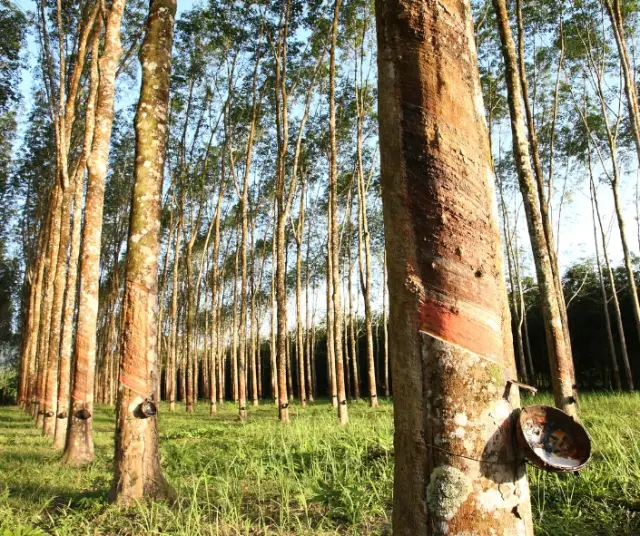Latex, a milky, viscous substance produced by certain trees and plants, has been a vital resource in various industries and applications throughout history.
Origins of Latex: Exploring History
Latex, whose history dates back to ancient Mesoamerican civilizations, finds its origins in the ingenuity and natural engineering of indigenous cultures, especially among the Aztecs and Mayans. It was in these lands that the unique properties of the milky substance released from certain trees and plants were discovered, a material that would later be known as latex. These civilizations used latex not only as a natural resource, but also as a fundamental tool for their daily needs.
The earliest application of latex by these cultures was in the manufacture of waterproof footwear, taking advantage of its water-resistant properties to create shoes that protected against inclement weather. Additionally, ancient Mesoamericans used latex in the creation of various objects, from play balls to utensils and toys for entertainment and cultural activities.
However, the relevance of latex was not limited to local practices. With the arrival of European explorers in the 15th century, this valuable natural resource became known worldwide. Expeditions led by figures such as Christopher Columbus and Hernán Cortés allowed knowledge about latex to transcend borders, taking it to Europe and other parts of the world. This cultural exchange marked the beginning of a new era for latex, transforming it from a local treasure into a global resource of great economic and commercial importance.
Natural Sources of Latex
Latex is mainly obtained from two types of natural sources: rubber trees and latex plants. Rubber trees, such as Hevea brasiliensis, are native to South America and have become the main source of commercial latex. The extraction of latex from these trees is an interesting and crucial process in global rubber production.
Latex Extraction Process
The latex extraction process is an artisanal practice that has evolved over the centuries, and continues to be a fundamental pillar in obtaining this valuable substance from rubber trees, mainly Hevea brasiliensis. The extraction procedure, known as bleeding, is essential to obtain quality latex without damaging the trees and ensuring sustainable production. Below is the process broken down step by step:
1. Identification of Latex Producing Trees:
The process begins by identifying suitable rubber trees for extraction. Hevea brasiliensis trees, native to South America, are the most commonly used due to the quality of their latex.
2. Making Incisions in the Cortex:
Harvesters practice the bleeding technique by making careful incisions in the bark of the tree. These incisions allow latex to flow from specialized ducts located just beneath the cortex. Skill and precision in this step are essential to avoid irreversibly damaging the tree.
3. Latex Collection:
The latex slowly flows from the incisions and is collected in a container strategically placed at the base of the tree. This milky liquid is a mixture of water, rubber and other substances, and its production is seasonal, with variations depending on the climate and the health of the tree.
4. Coagulation Process:
To convert latex into a usable form, a coagulation process takes place. Traditionally, substances such as formic acid or acetic acid are added to freshly harvested latex, causing the rubber to coagulate.
5. Formation of Rubber "Tears":
After coagulation, the latex becomes a solid mass known as rubber "tears." These tears are dried and collected for further processing in rubber factories.
6. Transportation to Factories:
The rubber tears are transported to factories, where they undergo additional processes such as smoking and laminating to convert them into final products such as rubber sheets, gloves or molded products according to market needs.
Global Production and Environmental Challenges
With the increasing global demand for rubber products, the mass production of latex has led to environmental concerns. The expansion of rubber tree plantations has led to deforestation in some regions, affecting biodiversity and contributing to climate change. Additionally, the heavy use of chemicals in rubber production has raised concerns about soil and water pollution.
Synthetic Alternatives and Sustainability
Growing environmental awareness has led to the search for sustainable alternatives to natural latex. Scientists have developed synthetic rubbers from petroleum derivatives, but these also pose challenges in terms of sustainability and dependence on non-renewable resources. New technologies and materials, such as rubber obtained from non-traditional plant sources, are being explored to address these issues.
Social and Labor Impacts
The latex industry has also been subject to concerns related to labor and social rights. In some regions, workers on rubber plantations have faced precarious working conditions and low wages. Certification and sustainability initiatives seek to address these issues, ensuring that latex production meets ethical and social standards.
Applications of Latex in Everyday Life
Latex plays an essential role in everyday life through a variety of products. From medical supplies such as gloves and bandages to consumer products such as toys, clothing and footwear, latex is found in many aspects of our daily lives. Understanding the latex supply chain allows us to appreciate the pervasiveness and importance of this substance.
As society moves towards more sustainable practices, the latex industry faces challenges and opportunities. Innovations in sustainable extraction, recycling of latex products and research into alternative sources promise a future where latex can remain a valuable resource without compromising the environment or human rights.
